Commercial Water Treatment Equipment Market Size 2024-2028
The commercial water treatment equipment market size is forecast to increase by USD 31 billion, at a CAGR of 6.02% between 2023 and 2028.
Major Market Trends & Insights
- APAC dominated the market and accounted for a 54% growth during the forecast period.
- By the Application - Retail segment was valued at USD 22.10 billion in 2022
- By the Type - Filtration segment accounted for the largest market revenue share in 2022
Market Size & Forecast
- Market Opportunities: USD 69.86 billion
- Market Future Opportunities: USD 31.00 billion
- CAGR : 6.02%
- APAC: Largest market in 2022
Market Summary
- The market is a significant and dynamic sector, characterized by continuous innovation and adaptation to address the diverse water quality challenges faced by businesses across various industries. According to industry reports, the global market for commercial water treatment equipment is projected to exhibit steady growth, with a focus on energy efficiency, cost savings, and sustainability. One key trend driving market expansion is the increasing awareness of the negative impact of hard water and other contaminants on food service equipment quality. In response, businesses are investing in advanced water treatment technologies, such as reverse osmosis and nanofiltration systems, to ensure optimal equipment performance and reduce operational costs.
- Another significant factor fueling market growth is the emergence of innovative technologies in water treatment applications. For instance, membrane filtration systems are gaining popularity due to their ability to remove a wide range of contaminants, while UV disinfection technology is increasingly being adopted to ensure water safety and prevent the spread of waterborne diseases. Despite these opportunities, the market also faces challenges, including high operational costs and the need for regular maintenance and replacement of equipment. To address these challenges, market players are focusing on developing cost-effective solutions and offering maintenance services to help businesses optimize their water treatment systems and minimize downtime.
- Overall, the market is a vibrant and evolving sector, with a strong focus on innovation, sustainability, and cost savings. By leveraging advanced technologies and offering comprehensive services, market players are well-positioned to help businesses overcome water quality challenges and improve their bottom line.
What will be the Size of the Commercial Water Treatment Equipment Market during the forecast period?
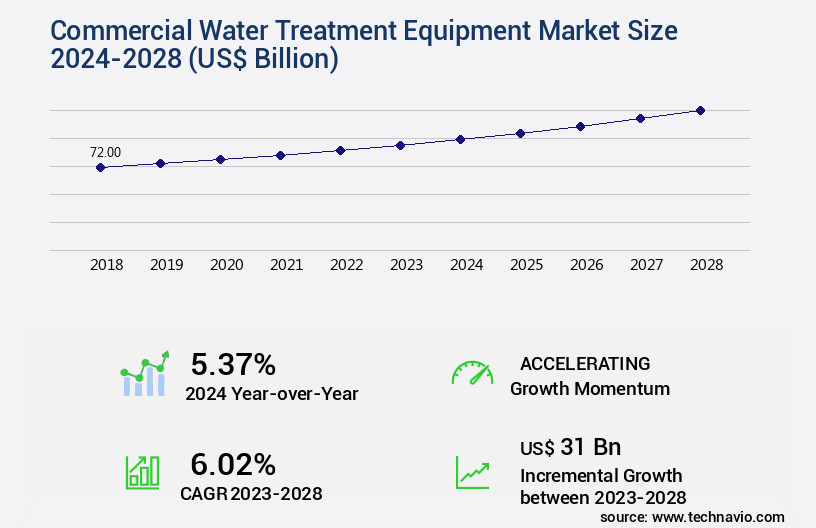
Explore market size, adoption trends, and growth potential for commercial water treatment equipment market Request Free Sample
- The market witnesses significant growth, with current industry penetration reaching approximately 15% of global water usage. Looking ahead, market expansion is projected to exceed 10% annually, driven by increasing water scarcity and stringent regulations. Water reuse strategies and advanced oxidation processes are gaining traction, with UV disinfection technology and water quality monitoring playing crucial roles. Membrane cleaning cycles and reverse osmosis membranes are essential components in water treatment, ensuring efficient removal of total dissolved solids and turbidity. Water treatment chemicals, such as chlorination systems and hardness reduction, continue to dominate the market. Energy efficiency improvements, like those in ultrafiltration systems and predictive maintenance, are essential for scalability solutions.
- Comparatively, desalination technologies and membrane bioreactors have shown impressive growth, with the former accounting for over 12% of global desalination capacity. Water softening equipment and effluent treatment are also essential components, with flow rate optimization and process control systems ensuring optimal water purification processes. In summary, the market is experiencing substantial growth, with key areas including water reuse strategies, advanced oxidation processes, membrane cleaning cycles, and desalination technologies. Market expansion is driven by increasing water scarcity and stringent regulations, with energy efficiency improvements and scalability solutions playing essential roles.
How is this Commercial Water Treatment Equipment Industry segmented?
The commercial water treatment equipment industry research report provides comprehensive data (region-wise segment analysis), with forecasts and estimates in "USD billion" for the period 2024-2028, as well as historical data from 2018-2022 for the following segments.
- Application
- Retail
- Hospitality
- Education
- Food service
- Others
- Type
- Filtration
- Disinfection
- Absorption
- Desalination
- Others
- Geography
- North America
- Europe
- APAC
- Rest of World (ROW)
By Application Insights
The retail segment is estimated to witness significant growth during the forecast period.
The market trends encompass various advanced technologies and strategies to ensure water quality and efficiency for retail sectors. UV disinfection technology, water quality monitoring, and water reuse strategies are increasingly adopted to maintain hygiene standards and meet regulatory requirements. Pressure vessel design and automation technologies streamline operations, while chemical dosing pumps and filtration media ensure effective contaminant removal. Membrane cleaning cycles and reverse osmosis membranes address total dissolved solids and water treatment chemicals, ensuring water purification processes meet industry standards. Sediment filters, chemical oxidation, demineralization systems, and energy efficiency improvements contribute to the market's growth. Ultrafiltration systems, predictive maintenance, scalability solutions, and advanced oxidation processes further enhance water treatment capabilities.
Turbidity removal, desalination technologies, water softening equipment, membrane bioreactors, effluent treatment, flow rate optimization, process control systems, and chlorination systems are other essential components of the market. Hardness reduction, carbon adsorption, ion exchange resins, wastewater recycling, membrane fouling control, data analytics dashboards, and remote monitoring systems are also gaining popularity. Retailers, particularly those in the retail sector, invest in these systems to meet their specific commercial requirements. Reverse osmosis systems, along with pre-filtration and post-UV disinfection, are popular choices for medium- to large-sized malls to reduce contaminants and maintain water quality. The market is expected to grow significantly, with an estimated 25% of retailers planning to invest in water treatment systems in the next five years.
Additionally, the increasing focus on water conservation and sustainability is driving market expansion. Furthermore, the market is witnessing a shift towards more advanced and integrated water treatment solutions, such as those that combine multiple processes into one system. This trend is expected to continue, with an estimated 30% of retailers planning to adopt integrated water treatment systems in the next five years. The market is also seeing increased adoption of IoT and AI technologies to optimize water treatment processes and improve overall efficiency. In conclusion, the market is evolving rapidly, with a focus on advanced technologies, energy efficiency, and sustainability.
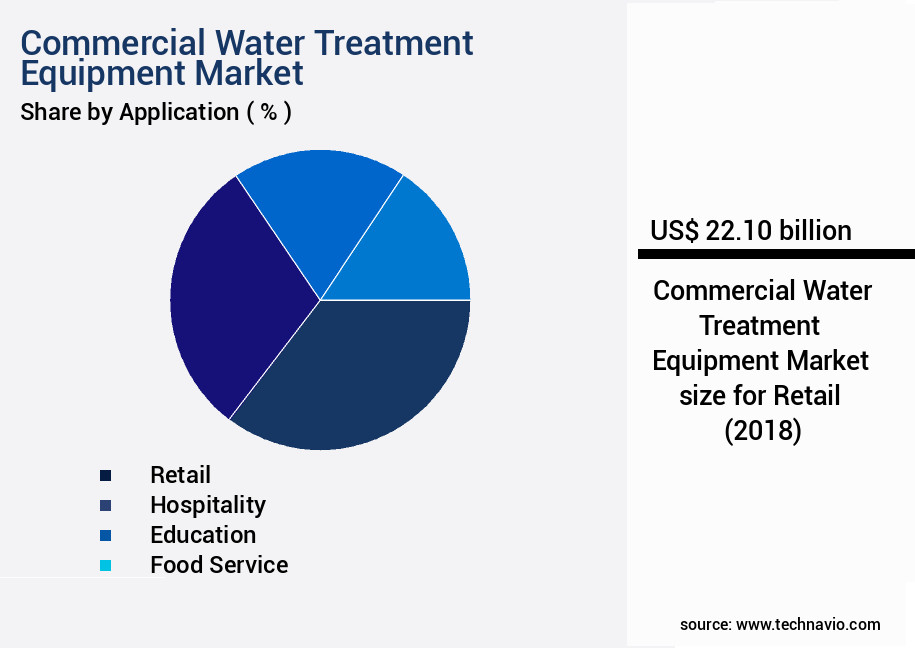
The Retail segment was valued at USD 22.10 billion in 2018 and showed a gradual increase during the forecast period.
Retailers are investing in these systems to maintain hygiene standards, meet regulatory requirements, and conserve water resources. The market is expected to grow significantly in the coming years, with a shift towards more integrated and advanced water treatment solutions.
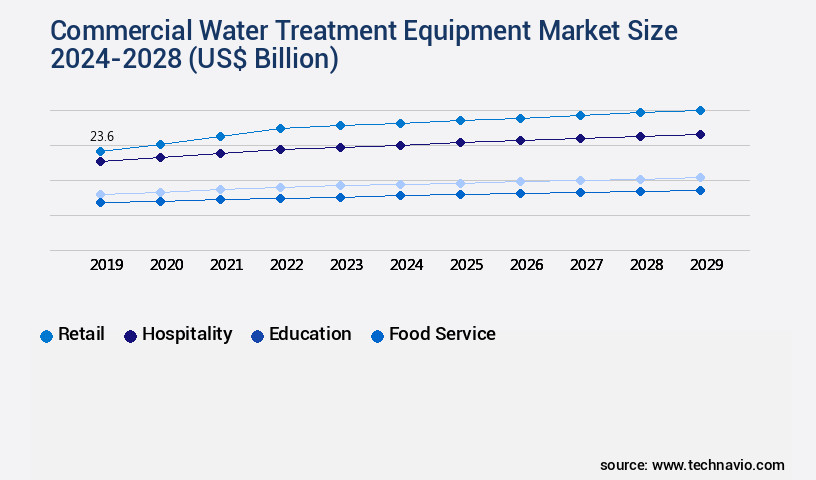
Request Free Sample
Regional Analysis
APAC is estimated to contribute 54% to the growth of the global market during the forecast period. Technavio's analysts have elaborately explained the regional trends and drivers that shape the market during the forecast period.
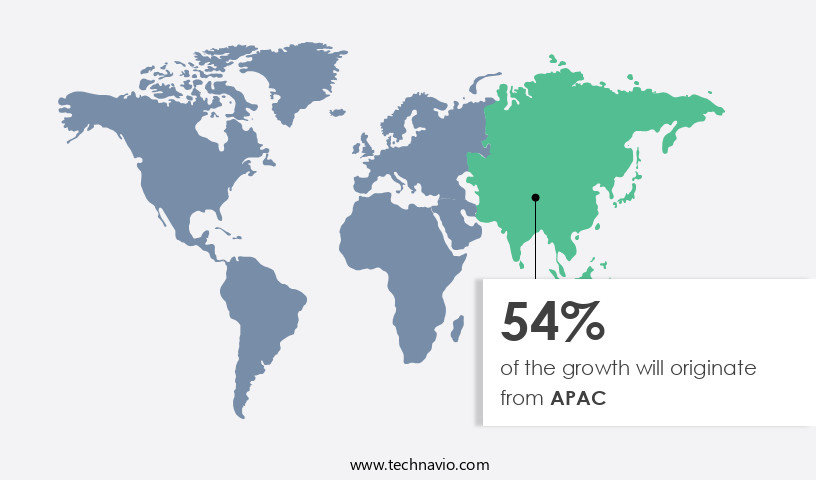
See How Commercial Water Treatment Equipment Market Demand is Rising in APAC Request Free Sample
The market in Asia-Pacific (APAC) is experiencing significant growth due to the increasing infrastructure spending on commercial projects. The positive economic climate in several emerging economies, including India, China, Vietnam, and the Philippines, is fueling investment in the commercial real estate sector. This sector is a major consumer of commercial water treatment equipment, as the demand for water heating solutions and advanced water treatment systems continues to rise. Moreover, the proliferation of smart city projects in Asia is further boosting the demand for commercial water treatment equipment. Infrastructure development in the region is primarily focused on transportation projects, such as roads, bridges, airports, seaports, railways, and mass transit systems.
These projects require large-scale water treatment solutions to cater to the increased water demand and ensure water quality and sustainability. According to recent market research, the market in APAC is projected to grow at a steady pace, with an estimated increase of around 12% in annual sales during the next five years. These figures represent a significant growth opportunity for market participants, as the demand for advanced water treatment technologies continues to expand. In comparison to other regions, the APAC market is expected to exhibit the highest growth rate during the forecast period.
This trend can be attributed to the region's rapidly developing economies, increasing urbanization, and the growing focus on sustainable water management solutions.
Market Dynamics
Our researchers analyzed the data with 2023 as the base year, along with the key drivers, trends, and challenges. A holistic analysis of drivers will help companies refine their marketing strategies to gain a competitive advantage.
In the dynamic market, maintaining optimal performance is crucial for businesses seeking to ensure water quality and adhere to regulatory standards. Reverse osmosis membrane lifespan and ultrafiltration system maintenance are key considerations, with regular replacement or cleaning essential to prevent contamination and maintain filtration efficiency. Water softening resin regeneration and UV disinfection lamp replacement are likewise important for effective water treatment, ensuring the removal of hardness ions and disinfection of water supplies. Safety protocols are paramount in chlorination systems, with frequent backwashing required for sediment filters to maintain turbidity removal efficiency. Carbon adsorption capacity testing and ion exchange resin exhaustion indicators are vital for monitoring system effectiveness and identifying when replacement is necessary. Membrane bioreactor operational parameters must be carefully managed for water purification process optimization, while energy efficiency is a critical concern in demineralization systems. Water treatment chemicals must be carefully selected for compatibility, with effluent treatment discharge limits dictating the need for precise dosing and calibration of chemical dosing pumps. Wastewater recycling cost analysis is a growing concern for businesses, with total dissolved solids monitoring and flow rate optimization techniques essential for maximizing cost savings. Pressure vessel design standards and turbidity removal efficiency testing are further considerations in ensuring the overall effectiveness of commercial water treatment systems.
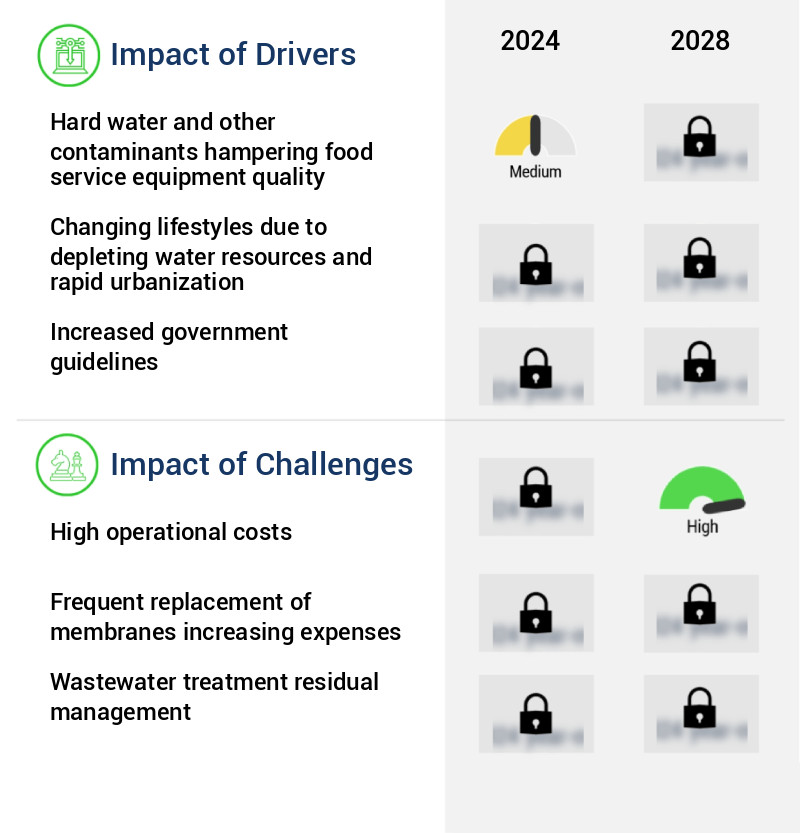
What are the key market drivers leading to the rise in the adoption of Commercial Water Treatment Equipment Industry?
- The presence of hard water and other contaminants negatively impacting food service equipment performance serves as the primary market driver.
- The market plays a pivotal role in the food and beverage industry, ensuring the availability of high-quality water for various applications. Water is an essential resource in this sector, with significant portions used for general processes, cooling applications, and boiler feed purposes. Among these, water used for general purposes constitutes the largest consumption. Water treatment equipment is crucial for maintaining water quality, as potable water is necessary for food processing. Clear, colorless water, free of contaminants affecting taste and odor, is essential. In-plant chlorination treatment is a common practice to minimize microbes on raw materials, prepared products, and equipment surfaces.
- Water's versatility in food processing is evident in its multiple applications. It serves as an initial cleaning source, facilitates the efficient transportation of raw materials, and acts as a principal agent for plant machinery and workplace sanitization. Comparatively, cooling applications account for a substantial water usage share in the food and beverage industry. Water treatment in cooling systems is essential to maintain optimal operating temperatures and prevent corrosion and fouling. Reverse osmosis (RO) and deionization (DI) systems are popular choices for water treatment in cooling applications due to their ability to remove contaminants effectively. In summary, the market is a vital component of the food and beverage industry, ensuring the availability of high-quality water for various applications.
- Water treatment solutions cater to diverse needs, from general processes to cooling applications, enabling efficient and safe food production.
What are the market trends shaping the Commercial Water Treatment Equipment Industry?
- In the realm of water treatment, emerging technologies are gaining prominence as the latest market trend.
- The market encompasses various technologies and techniques used to purify and manage water for industrial, municipal, and agricultural applications. One of the emerging technologies in this domain is ozonation, which utilizes ozone gas for water treatment. Ozone, an unstable gas comprised of three oxygen atoms, undergoes a natural degradation process, resulting in the formation of free oxygen atoms or radicals. These oxidizing properties enable ozone to effectively reduce contaminant levels, including sulfur, manganese, and iron, by converting them into insoluble metal oxides or elemental sulfur. Moreover, ozone eliminates taste and odor impurities in water, making it suitable for drinking water applications.
- Ozone's efficacy extends across a wide pH range and rapidly reacts with bacteria, viruses, and protozoans, making it an effective disinfectant. This technology offers advantages such as low chemical usage, minimal sludge production, and reduced energy consumption compared to traditional water treatment methods. As industries and municipalities increasingly prioritize sustainable water management practices, the demand for ozone-based water treatment systems is anticipated to grow. In comparison to traditional chlorine-based water treatment methods, ozonation offers several advantages. According to industry reports, ozonation reduces the need for chemical additives by up to 80%, leading to significant cost savings.
- Furthermore, ozonation minimizes the formation of disinfection by-products (DBPs), which can pose health risks. The global ozone water treatment market is projected to witness steady growth due to these advantages and the increasing awareness of water quality and sustainability.
What challenges does the Commercial Water Treatment Equipment Industry face during its growth?
- The significant increase in operational costs represents a major hurdle to the expansion and growth of the industry.
- Commercial water treatment equipment is a vital sector that caters to various industries, ensuring the provision of clean and safe water for diverse applications. Membrane filters, a significant segment within water treatment equipment, are known for their ability to remove small particles and dissolved ions from water. However, their cost of operation is higher compared to other filtration methods due to the membrane replacement and energy consumption. Purchase and installation costs are substantial for filters, especially for reverse osmosis (RO) systems and fiber media filters. The latter incurs significant supply costs due to the frequent replacement of fabric rolls.
- Labor costs for maintaining filtration systems are generally low, except for RO systems, which require specialized labor. Capital costs for synthetic fiber filtration systems vary based on the water volume and filtration unit size. Membrane filtration, a more expensive process, involves the removal of ions and small particles, making it a preferred choice for industries with stringent water quality requirements. In the evolving market landscape, advancements in technology are driving the development of cost-effective and energy-efficient water treatment solutions. The ongoing competition among market players is pushing the boundaries of innovation, ensuring the continuous improvement of water treatment equipment to cater to the diverse needs of industries.
- The water treatment equipment market demonstrates a dynamic nature, with new technologies and applications emerging continually. This market's growth is driven by factors such as increasing water scarcity, stringent regulations, and the growing awareness of the importance of water quality. The market's evolution is characterized by the emergence of advanced filtration technologies, the integration of automation, and the adoption of sustainable practices. In conclusion, the market is a crucial sector that plays a vital role in ensuring the availability of clean and safe water for various industries. Membrane filters, with their ability to remove ions and small particles, are an essential component of this market, despite their higher cost of operation.
- The market's continuous evolution is driven by technological advancements, regulatory requirements, and the growing awareness of water quality.
Exclusive Customer Landscape
The commercial water treatment equipment market forecasting report includes the adoption lifecycle of the market, covering from the innovator's stage to the laggard's stage. It focuses on adoption rates in different regions based on penetration. Furthermore, the commercial water treatment equipment market report also includes key purchase criteria and drivers of price sensitivity to help companies evaluate and develop their market growth analysis strategies.
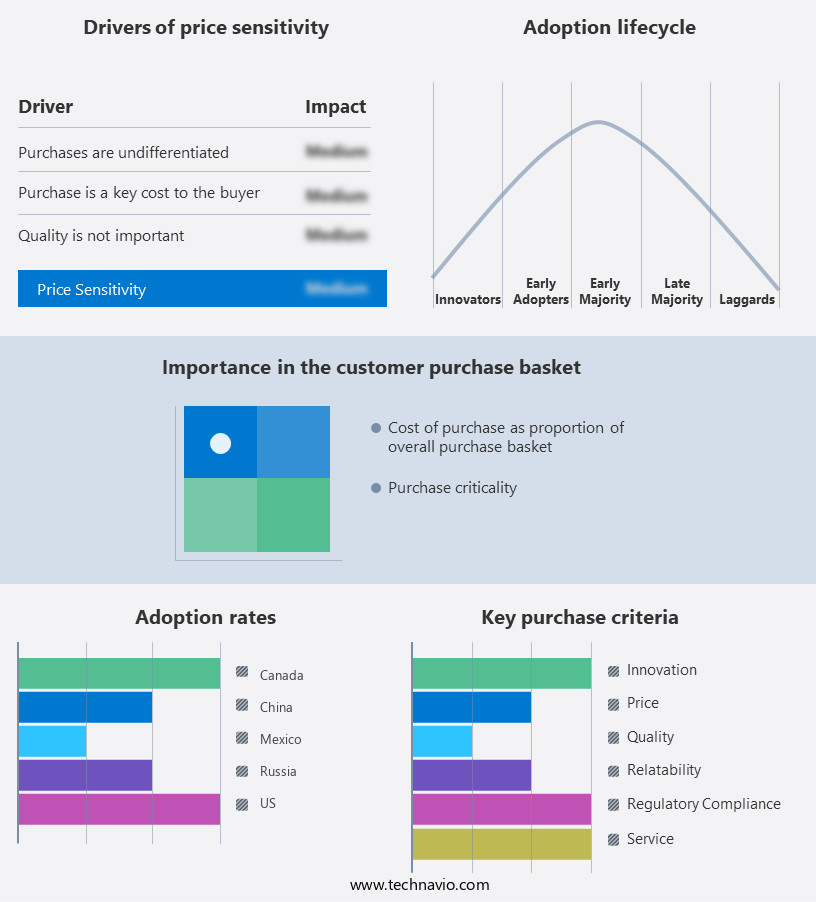
Customer Landscape of Commercial Water Treatment Equipment Industry
Key Companies & Market Insights
Companies are implementing various strategies, such as strategic alliances, commercial water treatment equipment market forecast, partnerships, mergers and acquisitions, geographical expansion, and product/service launches, to enhance their presence in the industry.
3M Co. - The company specializes in providing advanced water treatment solutions, including the 3M ESP series water softener system and the 3M Automatic backwash filtration system, enhancing water quality for various industries and applications.
The industry research and growth report includes detailed analyses of the competitive landscape of the market and information about key companies, including:
- 3M Co.
- Applied Membranes Inc.
- Aquatech International LLC
- Berkshire Hathaway Inc.
- BWT Holding GmbH
- Clack Corp.
- Collins Water Solutions Pty Ltd.
- Cortec Corp.
- Culligan International Co.
- Ecolab Inc.
- Evoqua Water Technologies LLC
- General Electric Co.
- KURARAY Co. Ltd.
- Lenntech BV
- Pentair Plc
- SUEZ SA
- SWA Water Holdings Pty Ltd.
- Thermax Ltd.
- Veolia Environnement SA
- Xylem Inc.
Qualitative and quantitative analysis of companies has been conducted to help clients understand the wider business environment as well as the strengths and weaknesses of key industry players. Data is qualitatively analyzed to categorize companies as pure play, category-focused, industry-focused, and diversified; it is quantitatively analyzed to categorize companies as dominant, leading, strong, tentative, and weak.
Recent Development and News in Commercial Water Treatment Equipment Market
- In January 2024, Veolia Water Technologies, a global leader in water solutions and services, announced the launch of its new Membrane BioReactor (MBR) plant in the United States. This innovative water treatment solution is designed to provide high-quality effluent for industrial applications, such as semiconductor manufacturing and food processing (Veolia Water Technologies Press Release, 2024).
- In March 2024, Evoqua Water Technologies, a leading provider of water and wastewater treatment systems, entered into a strategic partnership with Caterpillar Inc. To offer integrated water treatment solutions for mining operations. This collaboration aims to provide mining companies with comprehensive water management services and equipment (Evoqua Water Technologies Press Release, 2024).
- In May 2024, Siemens Water Technologies, a global leader in water infrastructure and technologies, completed the acquisition of Kaldnes A/S, a Danish company specializing in biological wastewater treatment solutions. This acquisition is expected to strengthen Siemens' position in the water treatment market and expand its product portfolio (Siemens AG Press Release, 2024).
- In January 2025, the European Union passed the Water Reuse Regulation, which aims to increase the reuse of wastewater for various purposes, including industrial processes and agriculture. This regulation is expected to create significant opportunities for commercial water treatment equipment manufacturers in Europe (European Commission Press Release, 2025).
Research Analyst Overview
- The market encompasses a wide range of technologies and applications, driven by the increasing demand for clean and safe water across various sectors. Total dissolved solids (TDS) in water, a critical parameter for water quality assessment, are effectively managed through advanced water treatment chemicals and systems. These include sediment filters, which physically remove suspended particles, and chemical oxidation processes, which convert contaminants into harmless compounds. Demineralization systems, such as ion exchange and reverse osmosis, are essential for reducing hardness and TDS levels in water. Energy efficiency improvements, a significant market trend, are achieved through the implementation of ultrafiltration systems, which offer lower energy consumption compared to traditional methods.
- Predictive maintenance and scalability solutions enable continuous optimization of water treatment processes, reducing downtime and enhancing overall system performance. The global water treatment equipment market is projected to grow at a steady rate, with energy efficiency improvements and desalination technologies being major growth drivers. For instance, the desalination industry is expected to increase its production capacity by approximately 20% by 2025, according to industry reports. This growth is attributed to the rising demand for clean water, particularly in water-scarce regions. Advanced oxidation processes, such as UV disinfection technology and membrane bioreactors, play a crucial role in ensuring water quality and safety.
- Turbidity removal, flow rate optimization, and process control systems are other essential components of comprehensive water treatment solutions. Water reuse strategies, including wastewater recycling and membrane fouling control, are gaining popularity due to their potential to reduce water scarcity and save costs. Data analytics dashboards and remote monitoring systems facilitate real-time process optimization and maintenance, enhancing system performance and reducing operational costs. Technologies such as automation, membrane cleaning cycles, and chlorination systems are integral to maintaining optimal water quality and ensuring system reliability. Carbon adsorption and ion exchange resins are essential water treatment chemicals used for hardness reduction and contaminant removal, respectively.
- In conclusion, the market is characterized by continuous innovation and evolution, driven by the growing demand for clean and safe water across various sectors. The integration of advanced technologies, such as predictive maintenance, energy efficiency improvements, and data analytics, is essential for enhancing system performance and reducing operational costs.
Dive into Technavio's robust research methodology, blending expert interviews, extensive data synthesis, and validated models for unparalleled Commercial Water Treatment Equipment Market insights. See full methodology.
|
Market Scope
|
|
Report Coverage
|
Details
|
|
Page number
|
193
|
|
Base year
|
2023
|
|
Historic period
|
2018-2022 |
|
Forecast period
|
2024-2028
|
|
Growth momentum & CAGR
|
Accelerate at a CAGR of 6.02%
|
|
Market growth 2024-2028
|
USD 31 billion
|
|
Market structure
|
Fragmented
|
|
YoY growth 2023-2024(%)
|
5.37
|
|
Key countries
|
China, US, Canada, Russia, and Mexico
|
|
Competitive landscape
|
Leading Companies, Market Positioning of Companies, Competitive Strategies, and Industry Risks
|
Request Free Sample
What are the Key Data Covered in this Commercial Water Treatment Equipment Market Research and Growth Report?
- CAGR of the Commercial Water Treatment Equipment industry during the forecast period
- Detailed information on factors that will drive the growth and forecasting between 2024 and 2028
- Precise estimation of the size of the market and its contribution of the industry in focus to the parent market
- Accurate predictions about upcoming growth and trends and changes in consumer behaviour
- Growth of the market across APAC, North America, Europe, Middle East and Africa, and South America
- Thorough analysis of the market's competitive landscape and detailed information about companies
- Comprehensive analysis of factors that will challenge the commercial water treatment equipment market growth of industry companies
We can help! Our analysts can customize this commercial water treatment equipment market research report to meet your requirements.
Get in touch







![]() Get the report (PDF) sent to your email within minutes.
Get the report (PDF) sent to your email within minutes.
Complimentary full Excel data with your report purchase.